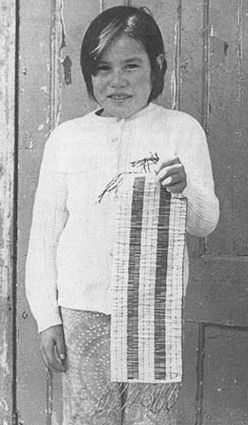Revolutionary War Two Road Belt

Cindy Boots displays Two Road Belt.
Reprinted from Wampum Belts of the Iroquois by Tehanetorens
At the beginning of the Revolutionary War the Iroquois tried to remain neutral, but it did not take them long to realize that neither the English nor the Americans intended to leave their country out of the war. One Indian compared his people to a piece of cloth between a pair of scissors, the scissors being the contesting white people and the Indians being the cloth that was cut. Such was to be the case, and it was not the first or the twentieth time that the Indian found himself in that position. England used every method to incite the Iroquois against the Americans, and the United States did not hesitate then, or in all of her wars, to use Indians to fight her battles. Both sides made many promises to the Indians for their aid, promises which neither white nation kept after the war was over and the aid of the Indians was no longer needed. Both sides offered scalp bounties, but the English went a little farther; they offered a larger reward for scalps than they did for prisoners, thus making killing more profitable. As the war progressed the Iroquois found themselves in a very trying position. Pressure from both groups was put on them. At a great council at Onondaga, the Capital of the Six Nations, they talked over the problem. Some were for helping Great Britain because of the ancient Treaty of Friendship and alliance made with her so many years before. Besides, had not the Americans broken the Treaty of a Forth Stanwix and crowded them from their lands? England promised them that in case Great Britain lost the war, the Six Nations would be given an amount of land in Canada equal to that lost in their present country. The Oneidas and Tuscarora's, members of the Iroquois League, did not want to fight the Americans due to the influence of Reverend Samuel Kirkland and the Christian New England Indians who had settled in their country. The white man had not yet reached their lands and crowded them off as they had done the Mohawks. You must remember that in order for the Iroquois to officially declare war, it was necessary for each state in their union to declare war. According to the Iroquois Constitution it had to be unanimous.
Council after council was held but all could not agree as to what policy to follow. The Mohawks were for war. The Onondagas were neutral. The Seneca's and Cayuga's were lukewarm to either side. The Oneidas and Tuscarora's sympathized with the struggling colonies.

Even within a nation all could not agree. Finally Thayendinagea, a Mohawk war leader, said, "Let each nation be responsible for its own members. Let each nation decide for itself what path it will take in this war. "He held up this wampum belt, which has on it the figures of two roads. They represent the road of the English and the road of the American colonies. The nations of the Iroquois could choose either road to follow. This belt, as well as the war, did harm to the Iroquois and helped to divide them.


Reader Comments(0)